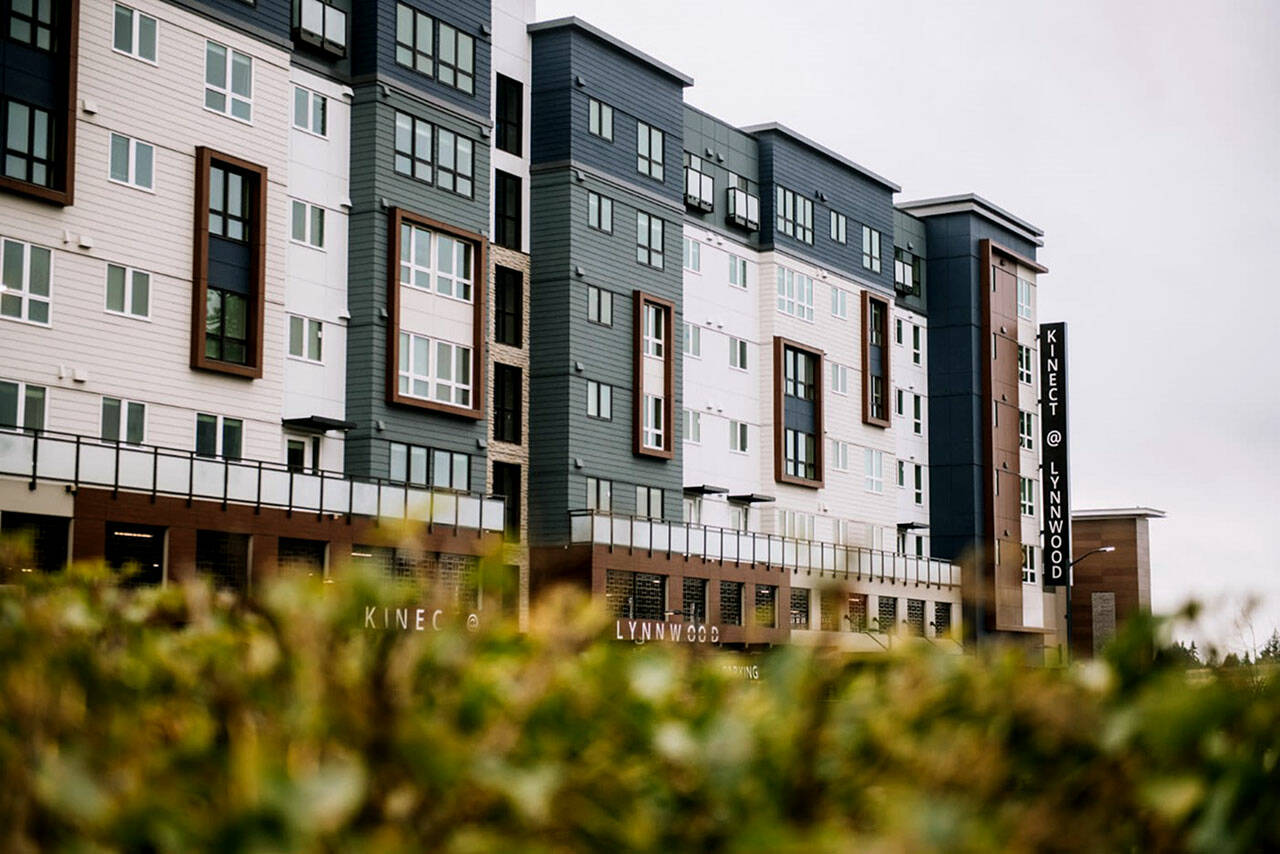LYNNWOOD — Over a decade ago, Lisa Utter and her fellow former city council members set out to make the city center the “heart” of Lynnwood.
Instead, they found the downtown core was more like a “pomegranate,” she said.
“It has no heart and it has no skin,” said Utter, who served from 1998 to 2009. “When I was knocking on doors, I would have people say to me: ‘I really just sleep here. I don’t pay any attention to what goes on in Lynnwood. There’s the mall and that’s it.’”
Back then, city council members began priming the 250-acre city center “sub-area” for growth, as the city made then-distant plans to become a transit hub with a new light rail station by 2024. They raised building height limits. They approved streetscape plans to be more pedestrian-friendly. And in 2012, the council adopted a planned action ordinance — speeding up the process to approve roughly 3,000 new homes within the city center.
Recently, the area began attracting mixed-use projects with shops and restaurants on the ground floor, too.
“We’re at that turning point,” City Center Program Manager Karl Almgren said. “We’ve been wanting to keep that moving forward.”
But momentum hit a speed bump with some current City Council members this year, as first reported by The Urbanist. Patrick Decker, Shannon Sessions and Jim Smith expressed reluctance to move forward with staff recommendations to increase the amount of pre-cleared housing and business space. Some Lynnwood residents had similar reservations.
“How many units do we need before somebody says stop?” Lynnwood resident and former councilmember Ted Hikel asked council.
After a “massive study” concluded this year, Almgren said, city staff and the city planning commission suggested doubling the number of homes, adding extra office space and building more hotels in the planned action area. The recommendations would bring Lynnwood’s standards in line with other Puget Sound cities.
After the April public hearing, the City Council sent staff back to the drawing board to answer questions about “safety concerns” in response to a growing population. Council President George Hurst is hoping to get the recommendations back in front of council before the August recess. If council members don’t adopt it, growth won’t stop, but it will be slower.
“I’m kind of surprised that I’ve read or heard from councilmembers, ‘It’s all happening at once,’ and ‘It seems pretty intense’ and they want to slow it down,” Utter said. “In fairness, light rail, to make it really work, requires pretty high density to support it.”
As an example, look to the Northgate Link stop that opened last fall. Around 2012, planners began to re-envision the north Seattle neighborhood with a hoppin’ light rail station.
“It’s a great place to locate housing because people can work the option for transit into their everyday lives in a real way,” said Geoffrey Wentlandt, land use planning manager for Seattle’s Office of Planning and Community Development.
An architecture firm hired by Seattle looked at the potential for towers and compact development that could help shift the area from an old mall to a “complete neighborhood.”
Simon Property Group, the owner of the mall, has driven some of the redevelopment in Northgate. The mall’s makeover as Northgate Station began in 2018, when Simon announced plans to tear down part of the shopping center in exchange for 1,000 apartments, nearly 1 million square feet of office space, two hotels and over an acre of green space.
In 2019, the area was “upzoned” to comply with a city code update requiring more affordable housing.
In 2021, an $80 million Seattle Kraken hockey practice facility opened near the mall.
And last October, light rail arrived in Northgate.
The hope is one day people will not be required to own a car, Wentlandt said.
Some of Northgate’s amenities have been driven by the market and light rail’s arrival. But to see a real transit-oriented community, local governments have some role in “priming the pump,” he said.
“The municipality sets the vision for what type of community they want,” Wentlandt said. That could be investing in a “safe pedestrian environment,” like parks. “People want to live near those amenities.”
In Lynnwood’s city center, some of the bigger changes are at least a decade out.
“It starts in different phases,” Almgren said. “Right now the phase is residential. But (it) is bringing new community members to the location, which will in turn drive new investments for those restaurant components, the retail components and those new investments. … When the light rail opens, we’re expecting that next phase to happen maybe a little bit faster.”
Sound Transit’s Lynnwood Link is just two years out.
By 2026, over 47,000 riders could be taking the train every day.
Lynnwood’s City Center will be the northernmost light rail stop until at least 2037, when the train line is slated to reach Everett.
In the meantime, the new Lynnwood light rail hub will transform.
Goodwill is slated to be home to a new park. Northline Village will turn 198th Street SW into a Southern California-style promenade lined with shops, cafes and offices. Alderwood Towne Center, now a 1980s strip mall, could be replaced with businesses towering over 100 feet.
“My hope is that my kids and my grandkids will be able to come into Lynnwood and live there,” said Hurst, Lynnwood’s City Council president. “Right now, if we don’t do a good job of managing the growth, by also providing some housing choices besides million dollar homes … I’m not sure if that generation is going to be able to.”
Isabella Breda: 425-339-3192; isabella.breda@heraldnet.com; Twitter: @BredaIsabella.
Talk to us
> Give us your news tips.
> Send us a letter to the editor.
> More Herald contact information.

























